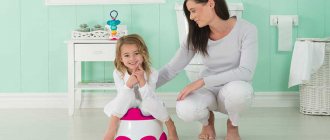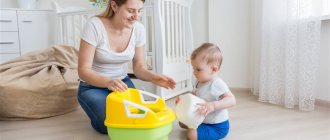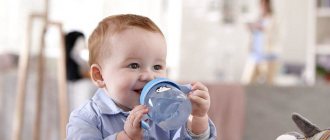Many mothers, as their baby grows, begin to think about the question of what is the optimal age for potty training, and how to do it correctly. There are many opinions regarding this situation. Some people advise doing this right from the cradle, while others recommend waiting.
After all, you should initially evaluate the baby’s development and his psychological preparation. If the child does not understand what this new item is for, then he will not consciously use it. Many experts recommend potty training after 1.5 years. During this period, the mental and physiological development of the child will allow this to be done without difficulty. Many mothers ask how to potty train at 2 years old. The article will discuss the features of this process, its subtleties and methods.
When to start potty training your child
Leading pediatricians assure that the fact that a child does not ask to use the potty until the age of two is a physiological norm. This is explained by the fact that a person cannot control the processes of urination and defecation independently until this age. However, perseverance and perseverance accelerate the development of such skills, which explains the success of previous generations. That is, if a child wears a diaper until he is two years old, then this is not a reason to grab your head and get upset, wondering when and how to potty train your child. There is a time for everything, as nature intended.
Useful tips from Dr. Komarovsky
The famous pediatrician Evgeny Komarovsky has repeatedly commented on potty training children.
The main thing that the doctor points out is to start teaching neatness skills only when the child is ready for it physiologically, and not because of comparison with other kids.
Komarovsky writes that the age of formation of toilet skills is 1-3 years. By the age of 3, the purpose of the potty and the ritual of its use are finally learned. Previously, potty training by developing a conditioned reflex to sound (“pee-pee”) is inappropriate, since after 1-1.5 years an awareness of natural needs begins to appear.
According to the pediatrician, the scheme for using the potty is as follows: full bladder - sitting on the potty - urination. Reflex emptying “sound – filling the bladder – potty” does not correspond to the correct understanding of the process of urination and defecation.
Komarovsky's recommendations:
- Potty training should begin no earlier than 1.5 years.
- Conscious use of the potty may only appear by the age of 3, so parents should not actively interfere and try to teach the child as early as possible. It's best to put off trying for a few months and then try again.
- One of the most important signs of readiness for toilet training is the ability to show parents in some way the desire to defecate.
- During training, parents must be consistent and not stop planting for a few days and then start again.
- It is best to potty train a child in the summer, when the child is not limited by a large amount of clothing.
- A good mood is the key to successful training.
- At first, you don’t need to completely give up diapers. They can be left for sleeping, walking, traveling.
- Planting on a pot should begin after sleep, eating or before a walk.
- Don’t focus on mistakes and give a lot of praise when you succeed.
Using the potty can be turned into a ritual game:
- take off your pants;
- sit on the potty;
- relieve yourself;
- dry off;
- put on pants;
- take out and wash the pot;
- to wash hands.
Potty training is an important stage in a child's growing up, so parents should act gently and actively support the baby, not skimping on praise.
Patience and a positive attitude will help parents and the baby cope with this difficult task and master a new type of activity.
Article design: Svetlana Ovsyanikova
It’s better not to argue with physiology!
Interestingly, from 6 months of age to one year, voluntary retention of bowel movements and urination develops. A child, in the process of exploring his body, can discover these possibilities, but it is still difficult for him to control them. During this period, you can invite your child to sit on the potty, but do not expect that after peeing there once, he will immediately begin to regularly ask and do his business there. A stable skill is formed a little later, when the child can already sit in one place.
Failure awaits those parents who decide to master the potty during the “crisis of the first year of life,” when the child rebels and demands independence. It happens that even those children who went to the potty before the crisis abruptly refuse to go out. When the problem period is over, the ideal time for training will come.
Another advantage for those who are thinking about how to potty train a child at 2 years old is the high probability that the child already understands the parents’ speech. Most children can already explain everything, tell them, and thus avoid unnecessary hysterics. How to teach a child?
The main stages of developing toilet skills
The periodization of the stages of teaching a child to control secretions was compiled by psychologist Alexander Kazmin. He specializes in working with young children and in his book “Diary of Early Child Development from Birth to 3 Years” he indicates the time frame for the formation of potty training skills. These age ranges are described conditionally, taking into account average age indicators.
| Approximate time frame for skill formation | Skill characteristic |
| 14 months | Reaction to soiled pants |
| 18 months | The desire to go to the toilet is accompanied by restless behavior |
| 22 months | With the help of gestures and sounds, the child tries to show the desire to have a bowel movement. |
| 2 years | Pants can remain dry for 2-3 hours. The child knows how to take off his underpants independently before sitting on the potty |
| 2 years 5 months | May indicate a desire to sit on the potty |
| 3 years | Able to sit on a potty, relieve major and minor needs, and put on pants |
There are increased requirements for the potty
If you understand that your child is now in a favorable period for training, the first thing you need to do is choose a potty.
Today on the children's goods market you can find an incredibly large assortment of them. Different colors, designs, shapes, sizes - there are pots for every, as they say, “taste and color”. It is better to start teaching with simple classic models so that the child is not distracted by drawings and other things, but to each his own. Let's look at what types of pots there are. It is better for a girl to buy a simple round pot on which she can sit with her legs together. The boy will feel more comfortable on an anatomically shaped potty that has a protrusion at the front. Pots come with or without a lid. The option with a lid is convenient for traveling, as well as in cases where parents do not have the opportunity to immediately dispose of the contents of the pot.
There are also pots with a footstool, from which the child steps on the footstool, thus holding the pot in place. Some versions have a special handle to make it convenient for parents to carry it out.
When it comes to materials, there is also plenty to choose from. Nowadays, parents mostly opt for plastic pots, but you can also find enamel options. The latter is durable, comfortable in shape and easy to maintain.
The plastic used to make modern potties and toilet seats may contain a special antiseptic additive that allows parents to wash the potty without adding detergents.
Many different options
There are also potty chairs, musical potties, toy-shaped models, transformable potties and travel options that fold and unfold. Some children initially prefer to sit on the toilet, so parents should pay attention to the child seat. Pediatricians are confident that all of the above nuances are not of fundamental importance, and the main thing is that the child perceives the potty not as a toy, but as a place to go when needed. Parents are advised to pay attention, first of all, not to the color and presence of musical accompaniment, but to the convenience, shape, and quality of the plastic. It is important that the potty heats up quickly from the baby’s body.
Introduction: how to potty train your child
When parents show their child the potty for the first time, they often don’t think about what important event is happening and how much attention needs to be paid to it.
The role is played by the child’s mood, the appearance of the potty, and the conditions in which the acquaintance takes place. What should I do? First, sit the child down and then tell him what’s what? Or vice versa? What if the baby thinks this is a new toy and doesn’t understand what to do? All these questions swarm in the minds of concerned parents who don’t know what the right thing to do is. There are several options for the development of events. If, for example, you did not introduce the child to the potty until the age of two, and he sees it for the first time, being already able to understand your explanation, you must first present the necessary information in accessible language. Ideally, the baby will sit on the potty and try to do something. In the worst case, he will turn away, leave and thereby upset mom and dad. If this happens, you should not impose and try to seat the child anyway. It’s better to hide the potty away and try again after a couple of weeks, when the baby has already forgotten about it. If the child does not sit on the potty again, hide it again and again until it works.
If the child is younger and does not yet understand the explanations, it is better to sit him down first and then tell him. Again, if it doesn’t work out, it’s better not to insist, so as not to frighten the baby even more and turn him away from this matter.
Another option is to try placing dolls and your favorite soft toys on the potty. Perhaps the child will want to follow their “example.” In general, it would be great to bring an older child who already knows how to go to the potty and show by his example what’s what. The good effect of this technique is confirmed by the fact that the second and subsequent children begin to go to the potty earlier, following the example of their older brothers or sisters.
The whole science or which pot to buy
Children's goods stores have a wide range of potties. They are varied in color and shape. They differ in the quality of the product material, the presence of lighting and music, etc.
The main condition when choosing a pot is convenience and functionality!
Recommendations when choosing:
- Product material. When a child sits on the potty, he should feel warm and comfortable. Most likely, a regular plastic one would be an excellent option.
- Form. For girls, a round shape is recommended, and for a boy, an oval shape with a thoughtful wall in the front.
- Sustainability. Little children are fidgety by nature. So that the child does not get scared and does miracles for the mother, the pot must be stable and have a rubberized base contour.
- Availability of a backrest. It is convenient and comfortable for the baby to sit on such a potty.
- Removable inner bowl. Convenient for travel. At home, you need to make sure that the little one doesn’t turn the pot over after the “process.”
- No lighting or music special effects. The baby will be constantly distracted.
- Financial part. Choose according to the “price – quality” principle.
Preparing for misses
If your child already sometimes goes to the potty, but does not do it completely confidently, it is better to abandon the diaper and prepare for the appearance of unwanted puddles in the middle of the room. During this period, it is better to remove the carpets and stock up on a change of linen. Having a diaper on the baby will only slow down the process and give parents even more headaches. Parents should also prepare themselves mentally: control themselves and not scold their child if he forgets about the potty. There are situations when the baby successfully goes to the potty when his mother sits him down, but the child does not ask to go to the potty on his own. It is important to understand that it is difficult for a child to accept innovation as quickly as others want, and it is better if he receives support and a smile instead of punishment.
The child may be scared!
There are cases when children begin to be afraid to write only because they do not want to be scolded by their parents, and they tolerate it, which negatively affects their well-being. You shouldn’t be surprised why a child (2 years old) is afraid of the potty if his parents constantly scold and punish him for something related to the potty.
Under no circumstances should you shout at a child while urinating (for example, when he has already started peeing in his pants, you should not shout “Hey, stop!” and so on). This can cause fear and prolong the period of uncontrolled urination during sleep.
When to take off your diaper for a walk
A child who goes potty at home with great success does not always communicate his intention to pee outside. It is better to put on a diaper first, since windy or cold weather can cause an unwanted cold (it is not a fact that you will have time to quickly run home or successfully change your child at the scene of the incident). The diaper should be removed only when it consistently remains dry after a walk, or when the child begins to ask to go potty outside the house. Another nuance is what to do if a child says that he wants to pee in some crowded place where there is no opportunity to do this. Often mothers sit their children down in the middle of the street, under a tree or bush. This is both right and wrong. It would be good to remember that the child needs amenities, and only walk in places where there is a toilet nearby. You can get a travel folding potty and carry it with you. This option adds confidence to the child, because often children do not ask to go outside just because the potty is not in sight.
How to refuse a night diaper
When the main problem is solved, and the child goes to the potty at home and outside, as a rule, one more question remains: how to train a child to potty at night. It has been proven that the baby will begin to wake up at night in order to go to the potty only some time after developing a stable skill of going to the potty during the day. Children whose parents stopped using disposable diapers stop peeing in their sleep earlier. After two years, thanks to urinary retention, many children “endure” until they wake up. It is rare that a child will sleep all night without waking up for these purposes, but if he drank a little and went to the potty before bed, there is a chance that he will wake up only in the morning and immediately go where he needs to go.
Retraining
It happens that a child who has mastered the use of a potty may suddenly stop defecating in it. This behavior in children is typical after stressful situations, age-related crises, or is a consequence of too early training.
Some of the most common reasons for the need to re-potty train include:
- Crisis 3 years. Characterized by negativism, stubbornness and refusal to perform usual actions.
- Teething . Severe pain prevents the child from focusing on sensations.
- Changing your usual lifestyle. Stress from moving, a long absence from mom, or going to kindergarten.
- Difficult emotional situation in the family. Screaming and showdowns affect the child’s subtle psyche and disturb his calm.
When retraining, it is important for parents to find the reason for the child’s refusal to use the toilet and try to overcome it. In addition, the use of different potty training methods helps twice as much, since the baby may not agree to go to the potty according to the pattern familiar to him.
To summarize: typical mistakes and general recommendations
- Under no circumstances should you scold a child for not going to the potty and peeing his pants; he may be scared not only of his parents, but also of the potty or even the process itself.
- If you “hit” the baby, you need to praise it, but don’t overdo it. There is no need to praise too much or reward the child with something. It is enough just to gently stroke the baby and say with a smile that he is doing well and that this should always be done.
- If the child can sit on the potty by himself, you need to give him freedom of action, and even if he asks to sit on the potty, try to make him do it on his own. Before potty training a child at 2 years old, you need to work on his independence.
- We need to take a particularly democratic approach to “accidents” at first, when the child is teething, when he is sick, when he is passionate about play, during the “crisis of the first year of life.” It’s better to wait and think over a plan so that you don’t have to worry about how to potty train your child at 2 years old.
- Don't forget about the goal! Remember that potty training a child is primarily about teaching him to pee. The child should not sit there just to be praised or not punished. The main goal of parents is to teach their child to control his body.
Various potty training techniques
There are many methods for potty training babies. Many of them are based on parents' personal experiences and may not be suitable for other children. However, the main methods of potty training are based on the work of preschool teachers. They have positive responses and are used not only in kindergartens, but also for potty training at home.
Techniques:
- 10 tights – replacing diapers with tights.
- Training in 7 days.
- Training in 3 days.
- Family example - demonstrating that parents also use the toilet.
- Play form (training in 1 day) - using rubber toys.











